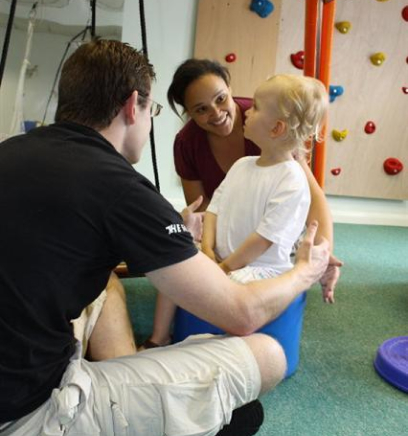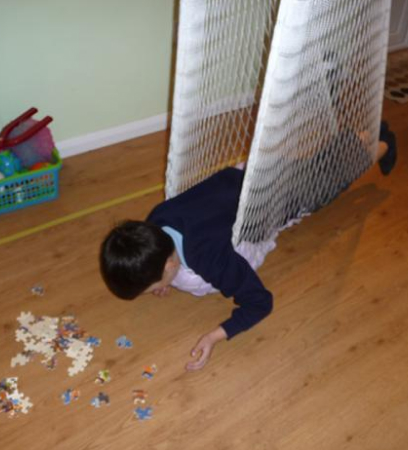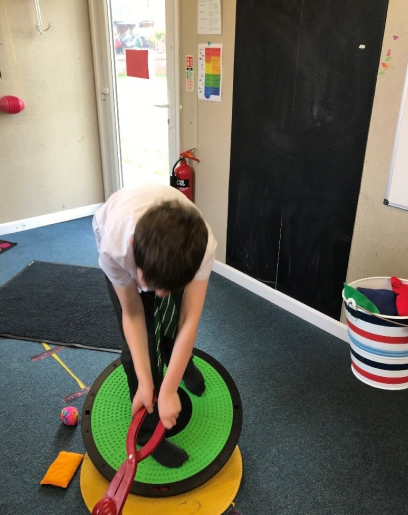Intervention may be in the form of


- Direct individual treatment sessions.
- Group treatment sessions.
- A target-based activity programme integrated into the home and school environments.
- Review or monitoring of the child’s progress.
Individual Treatment Sessions:
These last between 45 minutes to an hour, and includes active therapy and parent feedback. Sessions involve use of sensory, gross and fine motor equipment to encourage a child to participate in challenging activities.
A Sensory-motor approach uses equipment to develop skills whilst providing sensory experiences, for example; rather than practice bouncing and catching a ball, a child would be encouraging to bounce and catch whilst standing on a balance beam or wobble board.
A proportion of the session is usually based around foundation skills of neurodevelopment, gross motor and fine motor skills.
Treatment can be carried out at home, in school or at the clinic, and often depends on the nature of the session and the areas of development targeted.
Sessions will be designed around the use of one or several treatment approaches selected to meet your child’s needs.
Throughout treatment your child’s needs and difficulties will be continuously assessed to evaluate progress.
Each child progresses and develops at different rates and therefore it is important that the Occupational Therapist and parents work together to ensure the best possible and effective intervention is provided.
It is standard to expect a child to attend 8-12 weeks therapy before a review session. However a review can be arranged at any appropriate interval during therapy intervention.
Sensory Integration Therapy
Sensory integration therapy is designed to help children and young people develop their sensory processing. It provides a way to strategies to help them cope in all areas of their lives, including home and school. The therapy is based on the idea that some people struggle make sense of information provided by the 8 senses. For example, some children and young people over respond to some inputs such as being touched while others aren’t aware of sensations such as pain or spinning.
We assess a child and/or young persons sensory difficulties through thorough consultation with parents and teachers, as well as the child, and then develop a personalised treatment programme in which we use the most appropriate techniques and tools to overcome those difficulties.
Sensory integration therapy can involve a combination of different elements such as wearing a weighted vest, using sensory integration equipment such as swings and scooter boards, as well as our fantastic ball pool and climbing wall.
Our therapists are all highly skilled and experienced with this form of intervention. Prior to any therapy we will present clear outcomes and goals for the intervention, which will be reviewed on a regular basis.

Therapeutic Listening – please find more info at www.vitallinks.net
Developed by Vital Links, Therapeutic Listening is research based tool for treating people of all ages who have difficulty with processing sensory information, listening, attention, and communication.
Therapeutic Listening is a sound-based intervention often implemented as part of a comprehensive, multi-faceted therapy program, which encompasses much more than just the ears but the whole-body. Like other sensory systems, the auditory system does not work in isolation. Neurologically it is connected to all levels of brain function and as a result has a vast range of influence. How we listen impacts not only our overall physiology, but also our behaviour.
Wilbarger Brushing Protocol
The Wilbarger Protocol (also referred to as brushing therapy) is often a part of a sensory integration or sensory therapy program. It involves brushing the body with a small surgical brush throughout the day. People who exhibit symptoms of tactile defensiveness are extremely sensitive to touch. They often fear or resist being touched, have difficulty transitioning between activities, and may be lethargic. This therapy was developed by Patricia Wilbarger, MEd, OTR, FAOTA.
If you think that your child would benefit from the Wilbargar Protocol, it is important to seek guidance from an Occupational Therapist. The OT must be trained in sensory integration and must be specifically trained to use the Wilbargar Protocol. Performing the therapy in a manner other than taught by a trained professional may not be effective and can be very uncomfortable for the individual.
SOS Approach to Feeding
The Sequential Oral Sensory (S.O.S.) Approach to feeding is a trans-disciplinary program for assessing and treating children with feeding difficulties and weight/growth problems from birth to 18 years. It integrates posture, sensory, motor, behavioural/learning, medical and nutritional factors to comprehensively evaluate and manage children with feeding/growth problems.
“Aniesa has worked with my son for many years and his progress with her has been remarkable. Not only is her therapy room well equipped but Aniesa herself has been a great therapist in terms of technical knowledge and building relationships with us. Her relationship with our son is so good that he just marches into the therapy room with a big smile as if he owns the place; and at the end of a session, I feel that I’ve had a therapy session too! Aniesa is an expert at considering the needs of the whole family and I can’t recommend her highly enough. If I look at video clips of when our son first started and what he can do now, I’m blown away and grateful to Aniesa in equal measure.”
